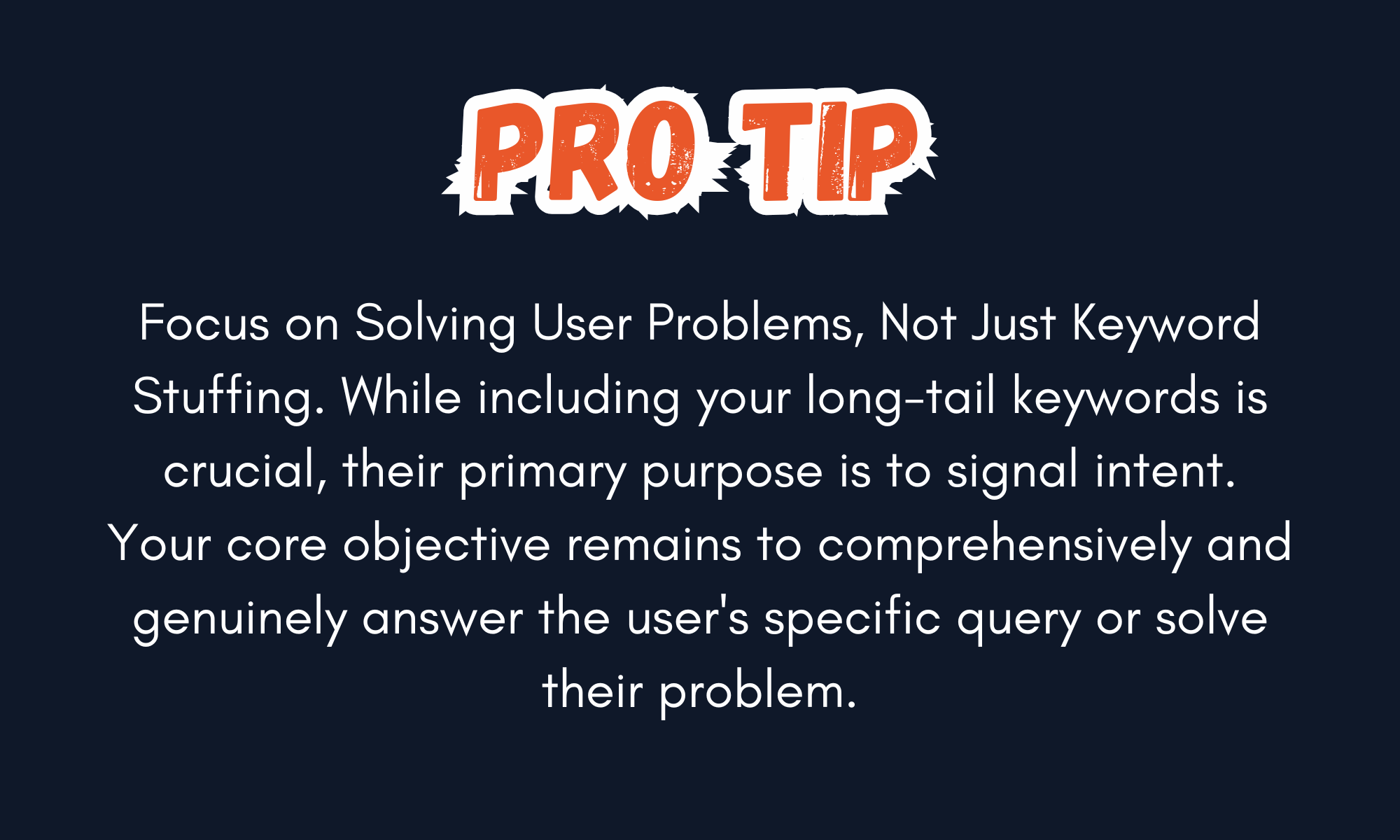Master Long-Tail Keywords for Targeted SEO Growth

Are you tired of battling for the top spot on highly competitive, generic keywords, only to see minimal return on your SEO efforts? In 2025, merely attracting traffic isn't enough; you need the right traffic – visitors genuinely interested in what you offer. This is where the strategic power of long-tail keywords comes into play, transforming your SEO approach from a broad sweep to a highly targeted, conversion-focused operation.
At Appear Online, we understand that the future of successful digital marketing lies in precision. This comprehensive guide will delve deep into long-tail keywords: what they are, why they're indispensable for driving qualified leads, how to unearth them, and crucially, how to weave them into your content strategy for maximum impact. Prepare to unlock niche traffic and significantly boost your conversion rates.
Understanding Long-Tail Keywords: Beyond the Basics
To truly harness their power, we must first clearly define what long-tail keywords are and how they differ from their shorter counterparts.
What Exactly Are Long-Tail Keywords?
Imagine a vast ocean of search queries. At the surface, you have the large, highly visible "head" of the fish – these are your short, generic keywords like "SEO" or "running shoes." They attract immense search volume but come with fierce competition and often vague user intent.
As you dive deeper, you encounter the "body" of the fish – slightly more specific phrases. Then, extending far into the depths, you find the "tail" – the long-tail keywords. These are typically phrases of three or more words, highly specific, and often more descriptive. Examples include "best running shoes for flat feet women" or "how to fix a leaky tap in kitchen."

Characteristics of Long-Tail Keywords:
- Specificity & Length: They are inherently more detailed, usually comprising three, four, or even more words. This specificity is their greatest asset.
- Lower Search Volume, Higher Conversion Rate: While individually they attract lower search volumes compared to head terms, their collective volume is significant. More importantly, users searching with long-tail phrases are often much further along in their buying journey or have a very specific informational need, leading to dramatically higher conversion rates. A user searching "digital marketing agency" might be browsing, but one searching "SEO agency for small businesses London" is actively seeking a solution.
- Reduced Competition: Because they are so specific, fewer websites are directly optimising for them. This means less competition, making it considerably easier for your content to rank well, even if your website is newer or has lower domain authority.
- Reflect User Intent: Long-tail keywords are excellent indicators of user intent. The detail in the query often reveals whether the user is looking for information (e.g., "what is content marketing"), navigating to a specific site (e.g., "login to Google Analytics"), making a commercial investigation (e.g., "best CRM software reviews"), or ready to make a purchase (e.g., "buy iPhone 15 Pro Max UK"). Understanding this intent is crucial for delivering the right content.
Why Long-Tail Keywords are a Game-Changer for Your SEO Strategy
Now that we've defined them, let's explore the compelling reasons why incorporating long-tail keywords is not just a best practice, but a strategic imperative for any business serious about online growth.
The Strategic Advantages of Targeting Long-Tail Keywords
- Attracting Highly Qualified Traffic: When someone types a highly specific phrase into a search engine, they're not just browsing; they're often seeking a very particular answer, product, or service. For example, a search for "best vintage record player under £500" indicates a specific need and a readiness to purchase, unlike a general search for "record player." By ranking for these detailed queries, you attract visitors who are already aligned with what your content or business offers, leading to significantly higher engagement metrics like lower bounce rates and longer time on page. This means more engaged users who are genuinely interested in your solutions.
- Boosting Conversion Rates: This is arguably the most significant benefit. Due to the clarity of intent behind long-tail searches, the traffic they bring converts at a much higher rate. These users are often at the "consideration" or "purchase" stages of the buyer's journey. Your content, precisely tailored to their specific query, acts as the perfect solution. Whether it's signing up for a newsletter, downloading an e-book, requesting a quote, or making a direct purchase, long-tail traffic consistently outperforms broad keyword traffic in driving desired actions.
- Easier to Rank (Less Competition): The competition for head terms like "SEO" or "marketing agency" is astronomical. Millions of websites are vying for the top spots, often requiring significant investment and authority. Long-tail keywords, by their very nature, are less competitive. There are countless variations, and fewer websites are specifically optimising for each unique phrase. This provides an invaluable opportunity for newer websites or those with lower domain authority to rank quickly and gain traction, building up credibility and traffic over time.
- Adapting to Voice Search and Conversational AI: The rise of voice search (via smart speakers and mobile assistants) and conversational AI has further cemented the importance of long-tail keywords. When people speak to their devices, they use natural, conversational language that is inherently longer and more specific than typical typed queries. Phrases like "Hey Google, what's the best Indian restaurant near me that delivers?" or "Alexa, how do I clean a stained carpet?" are prime examples of long-tail queries. Optimising for these helps your content appear in these increasingly common search scenarios, future-proofing your SEO strategy.
.png)
Finding Your Gold Mine: Effective Long-Tail Keyword Research
The key to a successful long-tail keyword strategy lies in your ability to unearth the most relevant and high-value phrases. It requires a blend of tool utilisation, creative thinking, and understanding your audience.
Unearthing High-Value Long-Tail Keywords for Your Niche
Leveraging Keyword Research Tools:
- Paid Tools (Ahrefs, Semrush, Moz Keyword Explorer): These are indispensable. Use their keyword explorer features to input broad terms related to your business. Then, apply filters to identify keywords with lower search volumes (e.g., under 100 or 200 per month) but good relevance and keyword difficulty scores. Look specifically for question-based queries (e.g., "how to," "what is," "best way to") as these are often naturally long-tail.
- Free Tools (Google Keyword Planner): While less feature-rich than paid alternatives, Google Keyword Planner can still provide valuable insights into search volume and competition for specific phrases. It's an excellent starting point for basic long-tail research.
Google's Built-In Features:
Google itself provides a wealth of long-tail inspiration directly within its search results pages:
- "People Also Ask" (PAA) Boxes: When you search for a query, Google often displays a "People Also Ask" section. These are direct questions users are asking, making them perfect long-tail keyword candidates. Expand these to reveal even more related questions.
- "Searches Related To..." at the bottom of SERPs: Scroll to the very bottom of a Google search results page, and you'll find a section titled "Searches related to [your query]." This is a rich source of related long-tail variations and semantic terms.
- Google Autocomplete: As you type a query into the Google search bar, the autocomplete suggestions often present popular long-tail phrases that users are searching for. It's a quick and easy way to brainstorm.
Mining User-Generated Content (UGC):
Real users, real questions. This is where authentic long-tail opportunities often reside:
- Forums & Q&A Sites (Reddit, Quora, industry-specific forums): Dive into discussions related to your niche. What questions are people asking? What problems are they trying to solve? The language they use in their questions is often naturally long-tail.
- Customer Support & Sales Teams: Your internal teams are a goldmine of long-tail keywords. Interview your customer support and sales representatives. What are the most common questions they receive? What are the biggest pain points customers express? These direct insights can fuel highly targeted content.
- Internal Site Search Data: If your website has a search bar, analyse the queries users type into it. This reveals exactly what information or products your existing visitors are looking for but might not be finding easily on your site.
Competitor Analysis for Long-Tail Gaps:
Use SEO tools to analyse your competitors' websites. Look at the keywords they are ranking for, particularly their long-tail positions. Identify any long-tail opportunities they might be missing, or areas where you can create more comprehensive, authoritative content than theirs. This competitive intelligence helps you spot content gaps and develop a strategic advantage.
.png)
Implementing Long-Tail Keywords into Your Content Strategy
Finding the keywords is only half the battle; integrating them effectively into your content is where the magic happens. A thoughtful content strategy, often built around the "pillar page and topic cluster" model, is crucial.
Crafting Content That Ranks for Long-Tail Keywords
The Pillar Page & Topic Cluster Model:
For comprehensive coverage and strong SEO, we highly recommend the pillar page and topic cluster model. This article you're reading is an example of a pillar page – it covers a broad topic (long-tail keywords) comprehensively but at a relatively high level. Supporting this pillar page would be cluster content – individual blog posts or articles that deep-dive into specific long-tail keywords related to the pillar (e.g., "how to use Google's People Also Ask for keyword research," "benefits of long-tail keywords for e-commerce"). The key is robust internal linking. Your pillar page should link out to all relevant cluster content, and each cluster piece should link back to the pillar page, as well as to other related cluster articles. This builds a strong, interconnected web of content that signals to search engines your expertise and authority on the overarching topic.
On-Page Optimisation for Long-Tails:
Once you have your long-tail keywords, meticulous on-page optimisation is vital:
- Title Tag & Meta Description: Your meta title (the clickable headline in search results) should be compelling, accurately reflect the content, and include your primary long-tail keyword, ideally near the beginning. Keep it concise, aiming for close to, but under, 60 characters to ensure it displays fully. Your meta description (the snippet below the title) should summarise the post's value proposition, include your primary keyword, and encourage clicks. Ensure it's between 150-160 characters.
- URL: Create a clean, descriptive URL that is concise and includes your primary long-tail keyword. Use hyphens to separate words for readability (e.g., youragency.com/blog/long-tail-keywords-seo).
- Headings (H1, H2, H3): Structure your content logically using a clear hierarchy of headings. Your H1 is the main title of your blog post and should contain your primary keyword. Use H2s to break down major sections and H3s for sub-sections. Naturally incorporate relevant keywords and long-tail variations into your headings where they enhance meaning and improve readability. Avoid simply stuffing keywords; they should sound natural.
- Body Content: Weave your long-tail keyword and its variations naturally throughout the article. The content should focus on comprehensively answering the user's specific query. Use synonyms and latent semantic indexing (LSI) keywords to enrich the semantic relevance of your text without sounding repetitive or unnatural.
- Image Alt Text: Don't forget your images! Use descriptive alt text for all images, incorporating relevant keywords naturally where appropriate. This helps search engines understand the image content and contributes to overall page relevance.
- Matching Search Intent: This cannot be stressed enough: always align your content with the user's search intent. If a long-tail query is informational (e.g., "how to reduce electricity bill at home"), your content should be an informative guide, not a sales pitch for energy-saving products. If it's transactional (e.g., "buy noise-cancelling headphones under £100"), your content should facilitate that purchase (e.g., a product review with clear links to purchase options). Failing to match intent will result in high bounce rates and poor rankings, regardless of keyword usage.
Internal and External Linking:
- Internal Linking: This is crucial for distributing "link juice" and improving site navigation. Within your blog post, identify relevant existing pages on your website (other blog posts, service pages, case studies) that logically connect to the current topic. Include relevant internal links to provide additional resources for readers and pass authority. A critical rule: only link to a specific internal page once per blog post. Use descriptive, keyword-rich anchor text that clearly indicates the content of the linked page.
- External Linking: When highly relevant and it genuinely adds value to your reader, include 1-2 external links to credible, authoritative sources (e.g., industry research, government websites, academic studies). These links lend authority to your content and demonstrate thorough research. Crucially, DO NOT link to competitors or e-commerce websites that might pull your users away from your site. Always set external links to open in a new tab (target="_blank") to keep users on your site.
.png)
Conclusion
Long-tail keywords are no longer a niche SEO tactic; they are a fundamental component of a successful, modern digital strategy. By embracing the specificity, lower competition, and higher conversion rates that long-tail keywords offer, your SEO agency can help businesses attract highly qualified traffic, boost their conversion rates, and build lasting online authority.
The digital landscape is constantly evolving, with voice search and conversational AI further underscoring the importance of natural, specific queries. By meticulously researching, strategically implementing, and consistently analysing your long-tail keyword performance, you'll be well-positioned to dominate your niche, drive meaningful results, and achieve sustainable SEO success for your clients. It's time to stop chasing fleeting broad traffic and start uncovering the gold in the long tail.
.avif)




.webp)

.webp)

